Procurement is, in many ways, a victim of its own success. As recently as 10 years ago, there was significant value to be gained by using competition to motivate better supplier performance and re-balance supplier profit margins and customer costs. The low-hanging fruit has been picked though, and supply management organizations are looking for new sources of value to deliver to their internal business partners. Recent Vantage research finds that leading companies, on average, realize 63% more of the value they target through strategic sourcing than the average company.

Unlocking that value is dependent on a mindset shift by procurement, from a traditional sourcing paradigm that focuses on cost reduction through supplier competition, to one that prioritizes internal and external collaboration to drive innovation.
Traditional Sourcing and Supply Management
|
New Sourcing and Supply Management Paradigm
|
As organizations shift to the new procurement paradigm, they similarly transition up the Vantage Partners Supply Management Maturity Model (below). They more closely align procurement and supply chain activities with enterprise business strategy and operations. They engage more frequently with cross-functional stakeholders. Consequently, they tend to realize more value from their procurement and supply management activities.
Over the past several decades, Vantage's research and work with clients has focused on helping sourcing and supply management organizations transform to meet the changing environment they operate in and capture the next wave of strategic value that comes from innovation from and with suppliers.
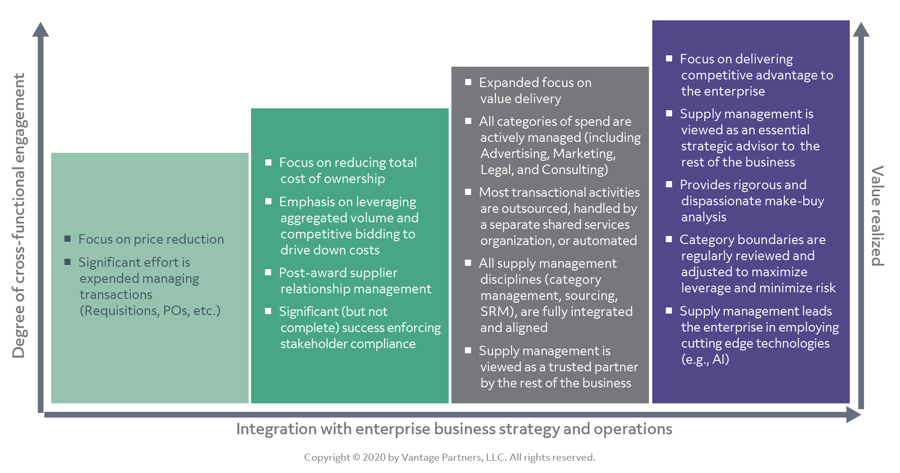
Strategic sourcing rests largely upon a set of concepts and principles laid out by Peter Kraljic in his classic Harvard Business Review article, “Purchasing must become supply management,” published in September 1983. The article is replete with many useful examples and case studies that remain relevant, as do many of the principles and methodologies of strategic sourcing that developed later.
What is noticeably absent from Kraljic's model? A mention of the word “innovation.” What’s more, his model viewed procurement through the lens of a manufacturing economy. That context is inconsistent with today's service-driven reality, where the value of intangible assets like patents and copyrights are rapidly eclipsing the value of physical assets at many organizations. Indeed, sourcing innovation is expected to triple as a percent of total sourcing activity over the next five years, recent research from Vantage Partners and the Institute for Supply Management finds.
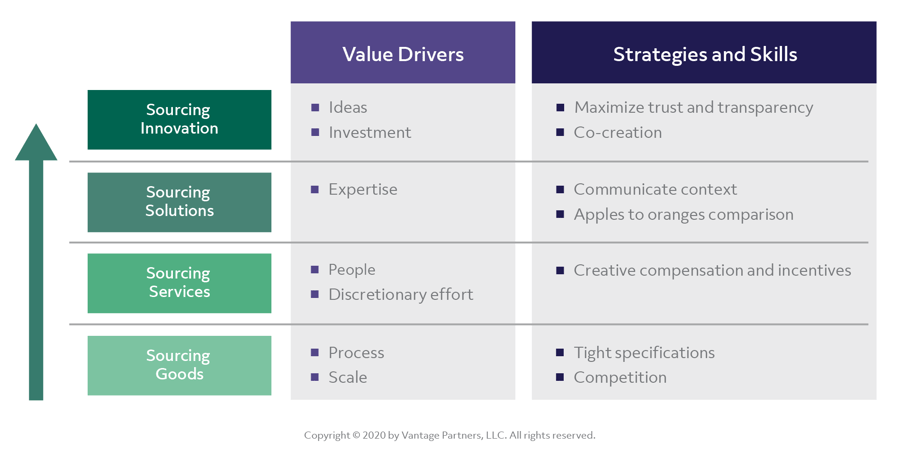
Roughly half of respondents report that currently, sourcing solutions or innovation comprises at most 10% of sourcing activity. |
Whereas nearly 40% state that ideally sourcing solutions or innovation should comprise more than 50% of sourcing activity. |
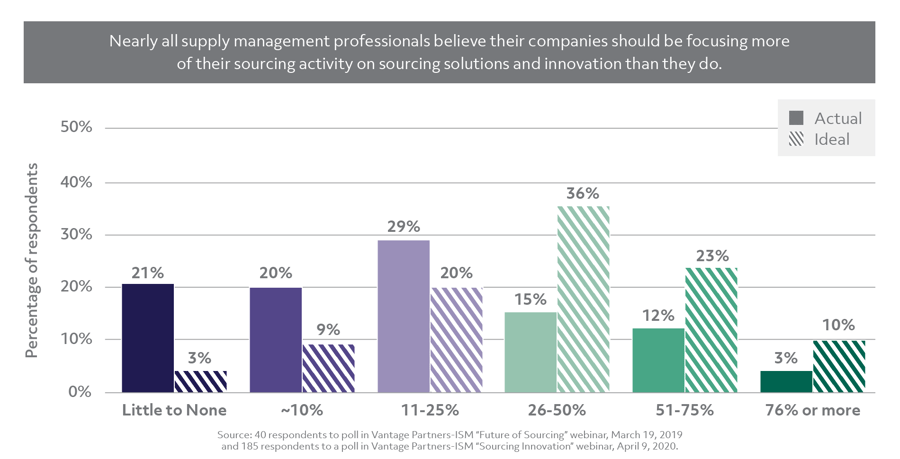
As the context of what procurement organizations are sourcing changes, how organizations are executing on sourcing and supply management activities is also rapidly evolving. New technologies are being deployed to automate processes like contracting and supplier performance management, while AI and machine-learning solutions are optimizing the supply chain and leading a proactive response to market changes.

Nine of the top 20 Fortune 500 companies indicated in their annual reports that digital technologies are crucial for their procurement operations. |
More than 75% of respondents note they are not currently using IoT technologies, AI, or Blockchain in their supply management activities. |
All respondents to Vantage/ISM's on-going supply management study report their organizations are planning to increase their use of these technologies in the next five years. |
Leading procurement organizations are transforming to become more strategically focused, leveraging technology and business process outsourcing to conduct transactional activities. Implementing these strategies requires a reevaluation of the sourcing organization as a whole, looking for how to optimally align team members to realize the value of digital and outsourcing strategies, minimize overlap, and restructure reporting lines to enable efficient decision-making.
The roles of buyer, contract administrator, and warehouse manager are decreasing in future-focused supply management organizations, while the number of strategic supplier managers, category leaders, and business partner liaisons are increasing. An overwhelming 83% of respondents to a study conducted jointly by Vantage Partners and the Institute for Supply Management reported their companies will have more strategic supplier relationship manager positions in the next five years, while 62% reported the number of transactional buyers in their sourcing and procurement organizations would decrease.
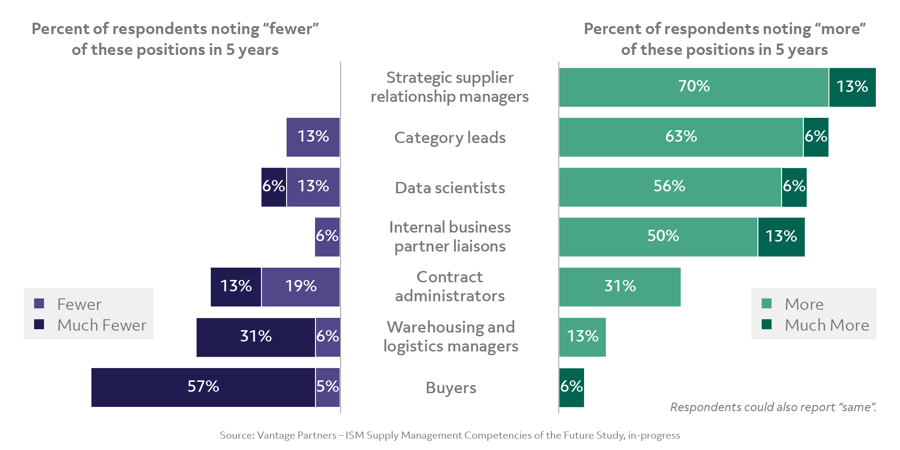
As the role of procurement functions become increasingly strategic, the skills needed for success have also evolved. Procurement and supply management leaders of the future will demonstrate mastery of behavior skills like influence, collaboration, and communication. Subject matter experts will lead new disciplines like data science and analytics, in support of procurement automation and strategic decision-making.
The Vantage Partners Procurement and Supply Management Competency Model puts a shift in attitude and mindset at the core of the skills evolution for procurement organizations. In this model, suppliers are viewed as business partners who can be leveraged as a competitive advantage (versus the traditional view of suppliers as vendors from which we buy goods and services).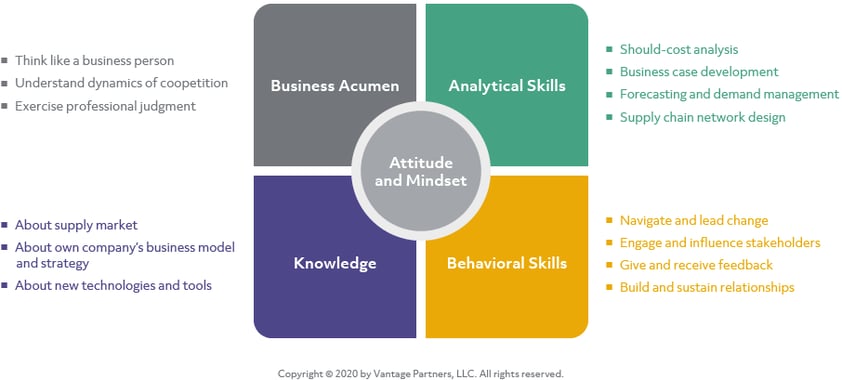
Sitting at the intersection of a company and its external suppliers, procurement can play a unique role in leveraging supplier assets and capabilities to drive innovation, actively support revenue growth and deliver competitive advantage—all while minimizing risk to a company’s operations and reputation. In other words, procurement can—and must—focus on maximizing total value from suppliers.
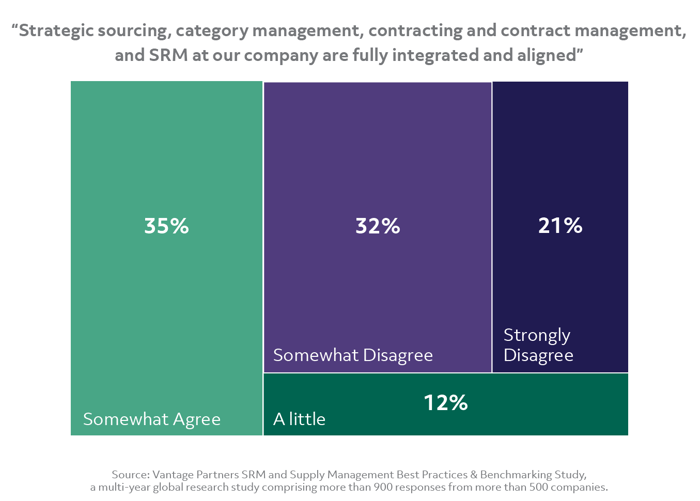
57% of respondents have formally defined SRM, category management, and negotiation process in place. |
Companies with all three formal processes in place realized, on average, 27% more of the potential value from their supplier contracts compared to those that have none in place. |
This requires an evolving toolkit for effective supply management activities. Recent research confirms what Vantage understood to be true from our nearly three decades working with leading procurement organizations. Companies with formal negotiation, category management, and supplier relationship management processes in place realize significantly more value than those that do not. Additionally, companies that align their category strategies, negotiation strategies, and supplier relationship strategies realize 17% more value from their strategic sourcing efforts, and 11% more potential value overall from their suppliers.
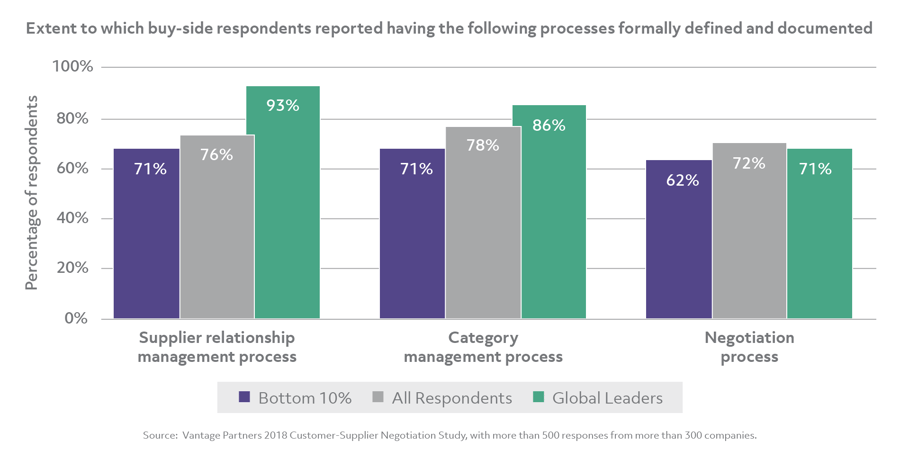
The Vantage Supply Management Academy is designed to enable participants to be more effective — and deliver competitive advantage to their organizations. We apply Vantage best practices and frameworks tailored to each client. We continually assess learning and measure business impact.
Over the past several decades, Vantage's research and client work have focused on helping sourcing and supply management organizations transform to meet changing conditions and capture the next wave of strategic value from innovation from and with suppliers. The Supply Management Academy is based on this extensive body of work.
All material contained on this website (except where noted) © Copyright 2024 Vantage Partners, LLC. All rights reserved.
+1.617.904.7800